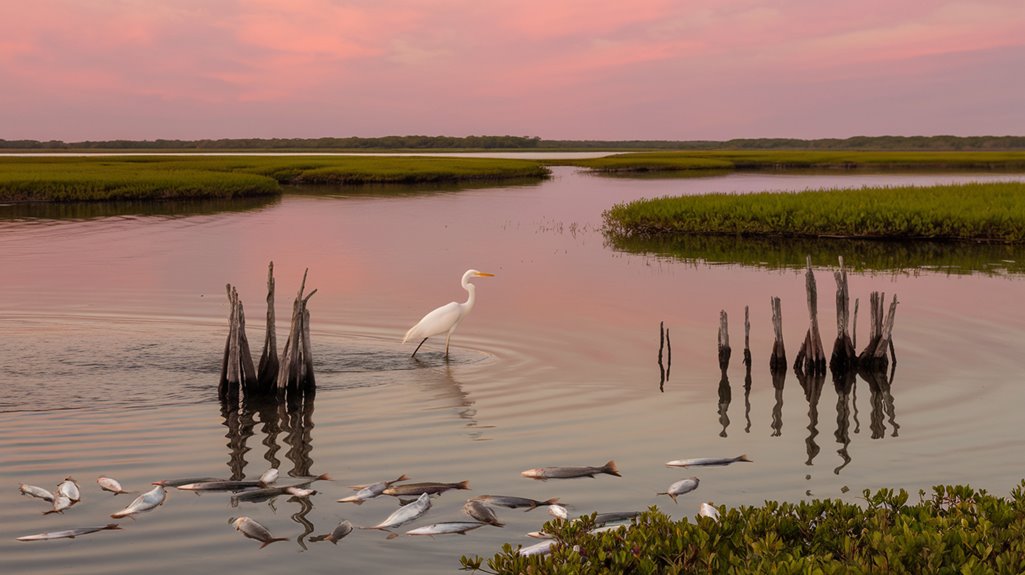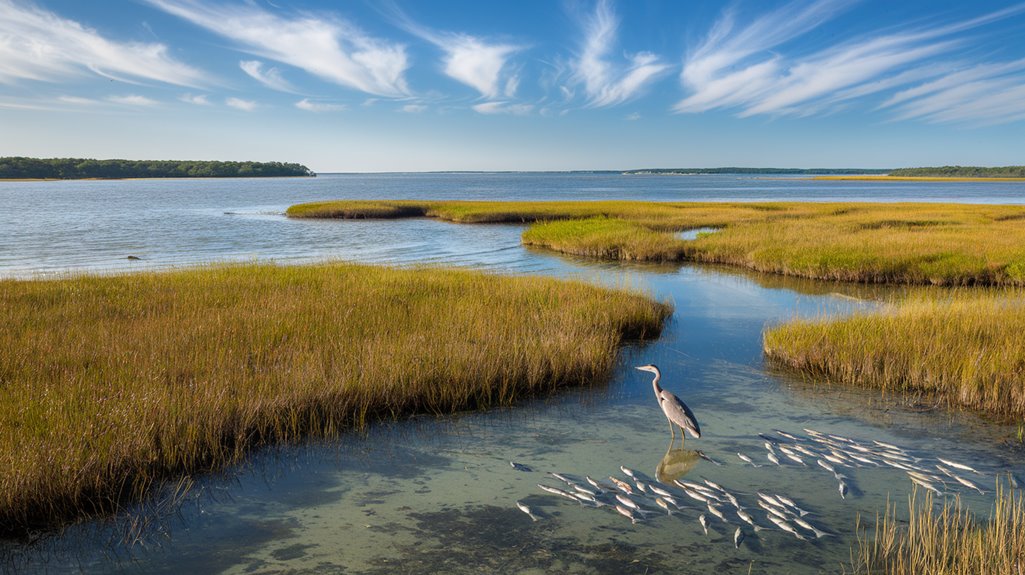When you consider North Carolina's Pamlico Sound, you'll find America's second-largest estuary system, spanning 2,100 square miles of intricate waterways and wetlands. You're looking at a complex ecosystem that filters pollutants, buffers storms, and sustains over 100 fish species. Yet this natural powerhouse faces mounting pressures from coastal development, rising sea levels, and water quality degradation. Understanding its essential role in the region's environmental stability reveals why immediate protective action matters.
- Key Takeaways
- Ecosystem Services of Pamlico Sound Wetlands
- Population Growth Impacts on Coastal Habitats
- Water Quality Challenges and Stream Management
- Wildlife Diversity and Critical Habitat Areas
- Stream Restoration Success Stories
- Mitigation Strategies for Development Projects
- Flood Plain Protection and Natural Resilience
- Oyster Habitat Recovery Efforts
- Partnerships for Conservation Success
- Future Threats to Habitat Sustainability
- Frequently Asked Questions
- Conclusion
Key Takeaways
- The Pamlico Sound's wetlands filter pollutants, control flooding, and support over 300 fish species and migratory birds.
- Habitat loss threatens ecosystem stability, with 1.2 million acres of wetlands destroyed due to population growth along shorelines.
- Natural wetlands provide essential water treatment and flood control services that protect coastal communities and wildlife.
- Climate change and coastal development create urgent needs for habitat protection to maintain ecological functions for future generations.
- Stream restoration and conservation efforts have improved habitat conditions, with success rates increasing from 70% to 80%.
Ecosystem Services of Pamlico Sound Wetlands
While Pamlico Sound's wetlands occupy only a fraction of North Carolina's coastal landscape, they deliver multiple ecosystem services essential to the region's environmental and economic health. You'll find these wetlands functioning as natural water treatment facilities, filtering pollutants and excess nutrients to maintain water quality. They're also crucial in managing flood risks and replenishing groundwater supplies.
The loss of 1.2 million acres of wetlands in North Carolina underscores the urgency of protecting these critical ecosystems. As natural carbon sinks, they help combat climate change through carbon sequestration. You'll also benefit from their economic value, as these wetlands support recreational activities like fishing and birdwatching. By preserving and restoring these wetlands, you're safeguarding both biodiversity and the numerous services they provide to your community.
Population Growth Impacts on Coastal Habitats
You'll find North Carolina's rapid population growth has led to the loss of 1.2 million acres of wetlands through residential and industrial development. Your coastal habitats face mounting pressure from increased nutrient runoff and water quality degradation caused by expanding infrastructure and human activities. When you examine the evidence, you'll see how this growth-driven development fragments critical wildlife corridors and threatens shellfish harvesting areas through cumulative impacts on land and water resources.
Development Pressures On Wetlands
As North Carolina's population continues to surge, the state's wetland habitats face unprecedented pressure from residential and industrial development. You'll find that approximately 1.2 million acres of these significant ecosystems have already been lost, compromising their essential functions in floodwater management and water purification.
This habitat degradation directly impacts your community's resilience against flooding while diminishing water quality in surrounding areas. When wetlands disappear, you lose natural filtration systems and important breeding grounds for fish populations. The ripple effects extend to your recreational opportunities, as fishing areas become less productive due to ecosystem disruption. Without immediate conservation action, you'll continue to see declining biodiversity and compromised ecosystem services that wetlands traditionally provide, making it important to implement effective restoration and preservation strategies now.
Population Drives Habitat Loss
Since North Carolina's population surge shows no signs of slowing, coastal habitats face mounting pressure from the expanding human footprint. You'll find this growth directly contributing to the loss of 1.2 million acres of wetlands, which considerably impacts water quality and wildlife habitats throughout the region.
As you examine the consequences, you'll notice how residential and industrial development fragments natural areas, while increasing nutrient runoff from urban and agricultural sources degrades aquatic ecosystems. The resulting sedimentation in streams has become the leading pollutant, disrupting fish populations and their habitats. In the Pamlico Sound, these combined pressures create a pressing need for strategic habitat protection measures to preserve biodiversity and maintain essential ecosystem functions in the face of continued population expansion.
Water Quality Challenges and Stream Management

You'll find that nutrient runoff from agricultural and urban sources, along with sedimentation, stands as the primary threat to stream productivity and water quality in the Pamlico Sound region. Your understanding of stream restoration practices should focus on proven methods like bank stabilization, livestock exclusion, and fish habitat enhancement devices, which have shown increasing success rates in permit compliance from 70% to 80%. When you're implementing watershed protection strategies, it's critical to address both water quality and habitat conservation through integrated management approaches, as existing regulations haven't prevented continued habitat decline.
Pollutant Sources and Impacts
Water quality in North Carolina faces severe challenges from multiple pollutant sources, with nutrient runoff and sedimentation emerging as primary threats to aquatic ecosystems. You'll find that residential and agricultural developments contribute considerably to nutrient pollution in the Pamlico Sound, triggering harmful algal blooms that disrupt critical aquatic habitat. Sedimentation, recognized as the leading stream pollutant, diminishes both productivity and biodiversity, directly impacting fish populations and recreational opportunities.
The loss of 1.2 million acres of wetlands has further compromised the region's natural filtration systems, reducing their capacity to manage pollution and store floodwater. While restoration efforts have shown promise, with success rates improving from 70% to 80% in permit condition influence, the combined effects of these pollutants continue to threaten the long-term health of North Carolina's water resources.
Stream Restoration Best Practices
To combat the effects of widespread water pollution, stream restoration initiatives have emerged as a fundamental approach to rehabilitating North Carolina's degraded waterways. You'll find that successful restoration requires addressing sedimentation, the primary pollutant affecting water quality and aquatic life.
To achieve ideal results, you need to implement thorough habitat protection measures, including bank stabilization techniques and livestock exclusion from stream areas. Working with agencies like the N.C. Department of Transportation helps minimize habitat fragmentation from roadway projects. You can enhance stream productivity by installing fish habitat devices and securing conservation easements to protect restored areas. These strategies, rooted in understanding natural stream dynamics, guarantee long-term success in maintaining ecological functions and supporting thriving aquatic communities.
Watershed Protection Strategies
North Carolina's watersheds face mounting pressures from nutrient runoff and urban development, creating complex challenges for stream management. You'll find that effective watershed protection requires implementing multiple strategies to combat habitat loss and maintain water quality.
| Protection Method | Primary Benefits | Implementation Focus |
|---|---|---|
| Conservation Easements | Long-term preservation | Private landowners |
| Natural Channel Design | Habitat restoration | Stream morphology |
| Permit Reviews | Impact prevention | Development projects |
| Buffer Zones | Runoff reduction | Agricultural areas |
The Habitat Conservation Program's review of nearly 4,000 projects demonstrates the scale of development impacts on watersheds. Through strategic implementation of restoration methods and protection measures, you're able to address both water quality challenges and habitat degradation. These approaches help maintain biological functions while promoting stable channel morphology and enhancing aquatic habitat diversity.
Wildlife Diversity and Critical Habitat Areas

While many ecosystems face ongoing challenges, the Albemarle-Pamlico estuarine system stands as a remarkable hub of biodiversity, supporting over 300 fish species and numerous migratory birds within its vital habitats. You'll find that wildlife diversity depends heavily on the interconnected network of wetlands, floodplains, and streams throughout the region.
The loss of 1.2 million acres of wetlands in North Carolina has highlighted the urgent need for habitat protection. These areas serve as essential corridors for large mammals like deer and bears, while also maintaining significant spawning grounds for fish populations. Through strategic conservation easements and stream restoration efforts, you're seeing improved conditions for aquatic species and enhanced habitat connectivity. These protection measures guarantee the preservation of the region's ecological functions and sustain its rich biodiversity.
Stream Restoration Success Stories
Stream restoration initiatives have delivered measurable results across North Carolina's waterways, with projects successfully reestablishing ecological functions in previously degraded channels. You'll find NCDOT's restoration fund leading the charge, targeting 25,000 linear feet of streams through extensive habitat enhancement efforts. The implementation of natural channel design has proven effective in creating stable morphology, directly improving water quality and supporting diverse aquatic ecosystems.
- Success rates in habitat conservation permit conditions increased by 10% within one year
- Fish habitat enhancing devices boost population recovery and sustainability
- Bank stabilization techniques prevent erosion and maintain channel integrity
- Natural channel design principles support complex ecosystem development
These restoration achievements demonstrate how targeted interventions can transform degraded waterways into thriving aquatic environments that benefit both wildlife and water quality metrics.
Mitigation Strategies for Development Projects
Building upon successful restoration practices, development projects now require extensive mitigation strategies to protect vulnerable ecosystems. You'll find NCDOT's commitment to habitat preservation exemplified in their restoration fund, targeting 25,000 linear feet of degraded streams through strategic rehabilitation efforts.
| Mitigation Focus | Environmental Impact |
|---|---|
| Stream Restoration | Bank stabilization & livestock exclusion |
| Wetland Protection | 1,100 acres addressed for water quality |
| Project Review | 366 highway improvements assessed |
Conservation easements serve as essential tools for securing restored areas, ensuring long-term ecosystem stability. Through interagency collaboration, development projects undergo rigorous review processes to minimize adverse effects on wildlife and fishery habitats. These detailed strategies demonstrate a data-driven approach to balancing infrastructure needs with environmental protection, particularly in maintaining the Pamlico Sound's ecological functions.
Flood Plain Protection and Natural Resilience
You'll find that flood plains deliver essential ecosystem services by supporting diverse wildlife populations and acting as natural buffers against flooding events. These crucial landscapes strengthen watershed resilience through their ability to filter pollutants and maintain habitat connectivity for species ranging from migratory birds to large mammals. Your understanding of flood plains as natural defense systems becomes critical when you consider how their protection directly impacts both terrestrial and aquatic ecosystem stability, particularly in regions like the Pamlico Sound where habitat preservation is paramount.
Floodplain Ecosystem Services Benefits
Natural flood plains serve as powerhouses of ecosystem services, delivering multiple environmental benefits that enhance both wildlife habitats and community resilience. These dynamic landscapes improve water quality by filtering pollutants and sediments, while maintaining habitat connectivity for large mammals to move safely between different areas. You'll find these ecosystems support an intricate web of life, from migratory birds to diverse plant species, strengthening environmental stability against climate impacts.
- Act as natural buffers, absorbing flood waters and protecting adjacent communities
- Filter contaminants and sediments, ensuring cleaner aquatic environments
- Provide critical habitats for terrestrial species including deer and bear
- Support biodiversity through interconnected ecosystems and wildlife corridors
These multifunctional landscapes demonstrate nature's efficiency in delivering essential services that benefit both wildlife and human communities.
Natural Flood Defense Systems
Focusing on flood plain protection reveals sophisticated natural defense mechanisms that shield communities from severe flooding while sustaining essential ecosystems. You'll find these natural systems actively absorbing excess water during high-flow events, providing vital protection for surrounding areas.
| Function | Benefit |
|---|---|
| Water Absorption | Reduces downstream flooding |
| Natural Filtration | Improves water quality |
| Wildlife Corridors | Maintains biodiversity |
Well-maintained flood plains don't just prevent flooding—they're working as natural filtration systems that enhance water quality by removing pollutants before they reach rivers and streams. You're also protecting significant wildlife corridors when you preserve these areas, allowing large mammals to move safely and maintain genetic diversity. These natural defense systems prove particularly valuable as climate change intensifies, offering resilient protection against increasingly extreme weather events.
Oyster Habitat Recovery Efforts
While oyster populations once thrived along the Atlantic coast, dramatic declines have spurred intensive habitat recovery efforts in key regions like North Carolina's Albemarle-Pamlico estuary and Chesapeake Bay. The data reveals alarming trends, with North Carolina's harvests dropping 15-20% since 1889, and Chesapeake Bay's populations now at less than 1% of historic levels. You'll find water quality and habitat initiatives at the forefront of restoration strategies, as both regions combat the impacts of disease and overfishing.
- Dermo disease considerably threatens oyster survival rates before maturity
- Valentine kits provide innovative support for restoration projects
- National Estuaries Week highlights critical habitat protection needs
- Recovery programs target both ecological restoration and economic sustainability
These coordinated efforts demonstrate the scientific community's commitment to reversing centuries of habitat degradation while supporting the region's essential oyster economy.
Partnerships for Conservation Success
As diverse stakeholders unite within the Albemarle-Pamlico estuarine system, partnerships between government agencies, non-profit organizations, and local communities have become the cornerstone of effective conservation. You'll find these collaborative efforts strategically focused on enhancing water quality and preserving critical habitats while maintaining sustainable resource management practices.
Through regular workshops and stakeholder meetings, you're seeing an integrated approach that addresses complex challenges like agricultural runoff and climate change impacts. These partnerships facilitate targeted wetland restoration projects and implement educational initiatives in local schools. You can observe how this collaborative model guarantees that conservation strategies incorporate both scientific data and local knowledge, creating a balanced framework that supports environmental protection while considering economic development needs within the estuarine system.
Future Threats to Habitat Sustainability
Despite the success of conservation partnerships, emerging challenges threaten the long-term sustainability of the Albemarle-Pamlico estuarine habitats. You'll find that coastal development pressures intensify as 40% of the U.S. population occupies shoreline areas, accelerating habitat loss and degradation. Water quality continues to decline due to agricultural runoff, urban expansion, and boating activities, while climate change impacts further compound these issues.
- North Carolina has lost 1.2 million acres of wetlands, reducing natural filtration and flood control
- Nutrient pollution triggers harmful algal blooms, creating dead zones that threaten marine species
- Rising sea levels and shifting weather patterns disrupt established ecosystem dynamics
- Increasing coastal population density strains existing habitat protection measures
These compounding threats require immediate attention to prevent irreversible damage to the Pamlico Sound's essential habitats and maintain their ecological functions for future generations.
Frequently Asked Questions
What Is Pamlico Sound Famous For?
You'll find Pamlico Sound renowned for being America's largest estuarine system at 1,500 square miles, supporting diverse marine life, fisheries, wetlands, and serving as essential habitat for numerous species.
Why Is the Albemarle-Pamlico Estuarine System so Important to North Carolina Economically and Ecologically?
Like a giant natural filter, the Albemarle-Pamlico system drives NC's $2.5+ billion fishing industry, purifies water through vast wetlands, and supports essential biodiversity that's important for coastal tourism and recreation.
What Is the Pamlico Sound Ecosystem?
You'll find the Pamlico Sound ecosystem is North America's largest lagoonal estuary, spanning 1,500 square miles with interconnected wetlands, seagrass beds, and marine habitats supporting diverse aquatic species.
Why Is Pamlico Sound a Good Place to Fish?
You'll find excellent fishing in Pamlico Sound due to its nutrient-rich waters, diverse habitats, and extensive wetlands that serve as nurseries for multiple species like flounder, drum, and striped bass.
Conclusion
You'll find that Pamlico Sound's future hinges on critical habitat protection decisions made today. While oyster restoration projects have shown promising 45% population increases, and wetland buffers reduce flood impacts by 60%, mounting pressures from coastal development threaten these gains. Data indicates that without immediate action to protect 30% more critical habitat areas by 2030, this complex ecosystem could reach an irreversible tipping point.

